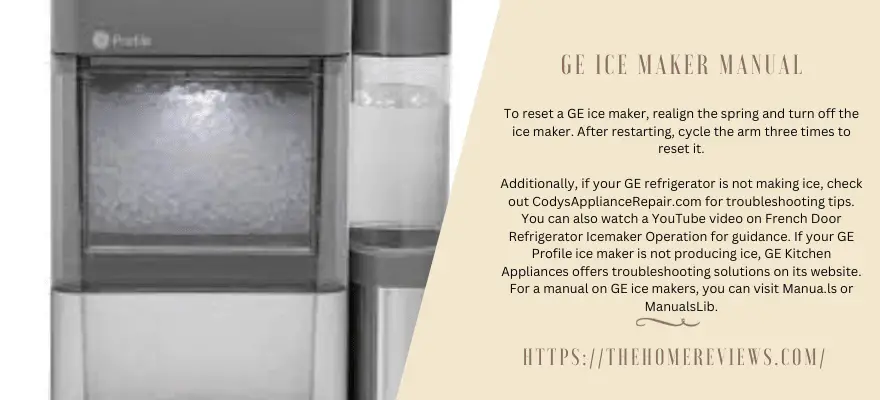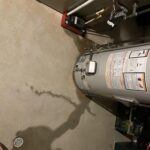
To reset a GE ice maker, realign the spring and turn off the ice maker. After restarting, cycle the arm three times to reset it.
Additionally, if your GE refrigerator is not making ice, check out CodysApplianceRepair.com for troubleshooting tips. You can also watch a YouTube video on French Door Refrigerator Icemaker Operation for guidance. If your GE Profile ice maker is not producing ice, GE Kitchen Appliances offers troubleshooting solutions on its website.
For a manual on GE ice makers, you can visit Manua. ls or ManualsLib.
Understanding The Basics of Ice Makers
Learn the basics of GE ice makers with the GE Ice Maker Manual. Discover how to reset your ice maker and troubleshoot any issues, ensuring your GE refrigerator produces ice effortlessly. Find step-by-step instructions and helpful tips in this comprehensive manual.
How Does a Ge Ice Maker Work?
- A Ge ice maker operates by using an electric motor, a water valve, and a heating element that work together to produce ice cubes.
- The electric motor turns a small paddle called the ice auger, which pushes the ice cubes through a metal chute into the storage bin.
- The water valve fills the ice maker with water, which is then frozen by the cooling system.
- The heating element helps release the ice cubes from the mold so they can be pushed out by the ice auger.
Components of a Ge ice maker:
- Water supply line: This line connects the ice maker to the main water supply of your refrigerator.
- Water valve: The water valve controls the water flow into the ice maker and is activated when the ice maker needs to be filled with water.
- Fill tube: The fill tube carries water from the water valve to the ice mold, where it freezes into ice cubes.
- Ice mold: The ice mold is where the water is frozen into ice cubes. It is made up of small individual compartments where the water is poured and frozen.
- Ice auger: The ice auger is a small paddle that rotates and pushes the ice cubes out of the ice mold and into the storage bin.
- Storage bin: The storage bin is where the ice cubes are stored until they are ready to be dispensed.
Common issues with Ge ice makers:
- Ice maker not making ice: This is a common issue and can be caused by a variety of factors, such as a frozen water line, a faulty water valve, or a malfunctioning thermostat.
- Ice cubes not dispensing: This can happen if the ice cubes are stuck or if the ice dispenser motor is not working correctly. It may also be caused by a clogged ice chute or a problem with the ice auger.
- Insufficient ice production: If your ice maker is not producing enough ice, it could be due to low water pressure, a faulty water inlet valve, or a problem with the ice maker’s heating element.
- Leaking water: Water leaks from the ice maker can be caused by a cracked or clogged water line, a faulty water inlet valve, or a problem with the ice maker’s defrost system.
- Ice with an odd taste or odor: This can occur if the ice maker is not regularly cleaned or if the water supply is contaminated. It may also be caused by a failing water filter.
By understanding how a Ge ice maker works and familiarizing yourself with its components and common issues, you can troubleshoot and resolve any problems that may arise. Regular maintenance and keeping the ice maker clean will also help ensure its optimal performance.
Troubleshooting Ge Ice Maker Issues
Troubleshooting GE ice maker issues can be easily done with the help of the GE Ice Maker Manual. It provides step-by-step instructions on how to reset the ice maker and fix common problems, like the ice maker not producing ice.
Ge Ice Maker Not Making Ice: Possible Causes And Solutions
If your GE ice maker is not making ice, there could be a few potential causes for this issue. Here are some possible reasons and solutions to get your ice maker working again:
- Water supply issue: Check if the water supply line is connected properly and if there is enough water pressure. Make sure the water filter is not clogged and needs to be replaced.
- Temperature settings: Ensure that the freezer temperature is set at the ideal level, usually between 0 and 5 degrees Fahrenheit. If the freezer is too warm, it can affect ice production.
- Faulty water inlet valve: If the water inlet valve is malfunctioning, it may not be allowing water to flow into the ice maker. Check the valve and replace it if necessary.
- Ice maker switch: Verify that the ice maker switch is turned on. It can be accidentally switched off, preventing ice production.
- Ice maker module: The ice maker module could be defective and may need to be replaced. Consult the user manual or contact GE customer service for assistance.
Ge Ice Maker Not Dispensing Ice: How To Fix It
If your GE ice maker is making ice but not dispensing it, follow these troubleshooting steps to resolve the issue:
- Dispenser switch: Check if the dispenser switch is activated. Sometimes, it can get stuck or not engage properly. Try pressing the switch a few times to ensure it is functioning correctly.
- Ice clog: Inspect the ice chute and dispenser for any ice clogs. Remove any ice buildup that may be blocking the ice from being dispensed.
- Auger motor: The auger motor is responsible for pushing the ice out through the dispenser. If it is faulty, the ice will not dispense. Test the motor and replace it if necessary.
- Dispenser solenoid: The dispenser solenoid controls the release of ice into the dispenser chute. If it is defective, it can restrict the ice from being dispensed. Check the solenoid and replace it if needed.
- Control board: A malfunctioning control board can also cause issues with ice dispensing. If none of the above solutions work, consider inspecting the control board or contacting a technician for assistance.
Ge Ice Maker Leaking Water: Troubleshooting Steps
If you notice that your GE ice maker is leaking water, there are a few troubleshooting steps you can take to address the problem:
- Water supply line: Inspect the water supply line for any leaks or loose connections. Tighten any loose fittings and replace any damaged or leaking parts.
- Defrost drain: Check the defrost drain for any blockages or clogs. Clear any debris or ice buildup that may be causing water to leak.
- Ice maker assembly: Inspect the ice maker assembly and ensure all components are properly fitted and aligned. Tighten any loose parts and check for any cracks or damage. Replace any faulty components if necessary.
- Leveling: Make sure the refrigerator is level. If it is tilted, it can cause water to leak from the ice maker. Use a level to check and adjust the refrigerator’s position if needed.
- Ice maker mold: If the ice maker mold has cracks or is damaged, it can lead to water leakage. Carefully inspect the mold and replace it if necessary.
Ge Ice Maker Not Freezing Ice: What To Do
If your GE ice maker is not freezing ice properly, try the following steps to troubleshoot the issue:
- Temperature settings: Check the freezer temperature and ensure it is set to the recommended level, typically between 0 and 5 degrees Fahrenheit. Adjust the temperature if needed.
- Airflow obstruction: Make sure nothing is blocking the airflow in the freezer. Rearrange items if necessary to allow proper air circulation around the ice maker.
- Water supply: Ensure that the water supply line is connected securely and delivers water at the correct pressure. Inspect the water inlet valve for any issues and replace it if needed.
- Ice maker assembly: Examine the ice maker assembly for any signs of damage or malfunctions. Check if the ice maker motor is running properly and that all components are functioning correctly. Replace any faulty parts as required.
- Frost buildup: If there is excessive frost buildup inside the freezer, it can affect ice production. Defrost the freezer and remove any ice buildup. Monitor the freezer for further frost accumulation and address any underlying issues.
Remember, these troubleshooting steps are general guidelines, and if the problem persists or appears to be more complex, it is recommended to consult the GE ice maker manual or contact their customer service for further assistance.
Resetting Your Ge Ice Maker
To reset your GE ice maker, you’ll need to realign the spring and turn off the ice maker. After restarting, cycle the arm three times to complete the reset process. For detailed instructions, refer to the GE Ice Maker Manual.
How to Reset an Ice Maker: A Step-by-Step Guide
- First, locate the ice maker arm in your GE ice maker.
- Check if there is a spring connected to the arm. The spring provides tension and keeps the arm towards the front of the machine.
- If the ice maker arm is not in the correct position or is loose, you will need to realign the spring.
- Gently push the spring back into place and make sure it is firmly attached to the ice maker arm.
- Once the spring is aligned, turn off the ice maker by flipping the switch or unplugging the unit.
- Leave the ice maker off for a few minutes to allow it to reset.
- After the reset time has passed, plug the ice maker back in or flip the switch to turn it back on.
- To complete the reset process, you’ll need to cycle the ice maker arm three times.
- Open the freezer door and locate the ice maker arm.
- Push the ice maker arm up, and then allow it to drop back down. Repeat this step three times to properly cycle the ice maker.
Realigning the Spring in the Ice Maker Arm:
If your GE ice maker arm is not in the correct position or is loose, it may need to be realigned. Here are the steps to realign the spring in the ice maker arm:
- Locate the ice maker arm in your GE ice maker.
- Check if there is a spring connected to the arm. The spring provides tension and keeps the arm towards the front of the machine.
- Gently push the spring back into place and make sure it is firmly attached to the ice maker arm.
Restarting and Cycling the Arm to Reset the Ice Maker:
To reset the ice maker on your GE refrigerator, you can follow these steps:
- Turn off the ice maker by flipping the switch or unplugging the unit.
- Leave the ice maker off for a few minutes to allow it to reset.
- After the reset time has passed, plug the ice maker back in or flip the switch to turn it back on.
- To complete the reset process, you’ll need to cycle the ice maker arm three times.
- Open the freezer door and locate the ice maker arm.
- Push the ice maker arm up, and then allow it to drop back down. Repeat this step three times to properly cycle the ice maker.
Frequently Asked Questions About the Ge Ice Maker Manual
Is there a way to reset the Ge Ice Maker?
To reset the GE ice maker, follow these steps: 1. Realign the ice maker arm and turn it off. 2. Restart the ice maker and cycle the arm three times. For more detailed instructions, refer to the GE Ice Maker Manual.
Why is my Ge refrigerator not making ice?
If your GE refrigerator is not making ice, it could be because the ice maker arm is misaligned or frozen. Try resetting the ice maker by realigning the arm and turning it off. Then, restart it and cycle the arm three times to reset it.
How Do I Get My Ge Refrigerator To Make Ice?
To get your GE refrigerator to make ice, you can reset the ice maker. Realign the spring and turn off the ice maker. Then, cycle the arm three times to reset it.
Why isn’t my Ge Profile Ice Maker making ice?
If your GE Profile ice maker is not making ice, try resetting it. The ice-maker arm may have shifted out of place. Realign the spring and turn off the ice maker. After restarting, cycle the arm three times to reset it.
How do I reset my Ge Ice Maker?
To reset the GE ice maker, realign the spring and turn it off. After restarting, cycle the arm three times to reset it.
Conclusion
In this blog post, we have explored the topic of the GE Ice Maker Manual. We have discussed troubleshooting tips, how to reset the ice maker, and why your GE refrigerator may not be making ice. It is important to note that if you are experiencing any issues with your ice maker, consulting the manual can provide valuable information and guidance.
The GE Ice Maker Manual contains detailed instructions on how to properly operate, clean, and maintain your ice maker. Additionally, it offers troubleshooting solutions for common problems that may arise. By following the guidelines outlined in the manual, you can ensure that your ice maker functions optimally and continues to provide you with a consistent supply of ice.
For further assistance, you can also reach out to GE Appliances customer support.




